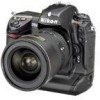Nikon D2H D2H User's Manual - Page 128
Taking Photographs-Flash Photography, Notes on Optional Speedlights
 |
UPC - 018208252084
View all Nikon D2H manuals
Add to My Manuals
Save this manual to your list of manuals |
Page 128 highlights
Taking Photographs-Flash Photography Notes on Optional Speedlights Refer to the Speedlight manual for detailed instructions. If the Speedlight supports i-TTL or D-TTL flash control, refer to the entry for digital SLR cameras in the table of camera types. If Auto FP High-Speed Sync is not used, the shutter will synchronize with an external flash at speeds of ½50 s or slower. If the flash-ready indicator blinks for about three seconds after a photograph is taken with i-TTL or D-TTL flash control, the photograph may be underexposed. The SB-28DX displays exposure in increments of 1/3 EV. If the camera is set to control exposure in increments of ½ EV using Custom Setting b2, the SB-28DX exposure display will not show the correct ISO value. The actual exposure value is not affected. i-TTL and D-TTL flash control can be used to adjust flash output at sensitivity (ISO equivalency) settings between 200 and 1600. At settings of HI-1 and HI-2, the desired results may not be achieved at some ranges or aperture settings. The AF-assist illuminator on SB-series 80DX, 28DX, 28, 27, 26, and 24 Speedlights will only light if all of the following conditions are met: focus mode is set to single-servo auto, an AF-Nikkor lens is used, the subject is poorly lit, and the center focus area is selected or dynamic-area AF is used in combination with closest-subject priority. In programmed auto, the maximum aperture (minimum f/-number) is limited according to sensitivity (ISO equivalency), as shown below: Maximum aperture at an ISO equivalent of: 200 250 320 400 500 640 800 1000 1250 1600 4 4.2 4.5 4.8 5 5.3 5.6 6 6.3 6.7 For each one-step increase in sensitivity (e.g., from 200 to 400), aperture is stopped down by half an f/-stop. If the maximum aperture of the lens is smaller than given above, the maximum value for aperture will be the maximum aperture of the lens. When an SC-series 17, 28, or 29 sync cable is used for off-camera flash photography, correct exposure may not be achieved in i-TTL or D-TTL mode. We recommend that you choose spot metering to select standard i-TTL or D-TTL flash control. Take a test shot and view the results in the monitor. In i-TTL or D-TTL mode, use the flash panel provided with your Speedlight. Do not use other panels such as diffusion panels, as this may produce incorrect exposure. D-TTL flash control can not be used for multi-flash photography. 116















